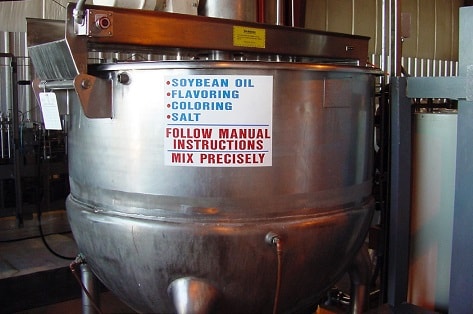Flavoring-related Lung Disease

Photo by NIOSH
Diacetyl (2,3-butanedione) and its substitute, 2,3-pentanedione (acetyl propionyl), are flavoring chemicals used in food flavoring and production industries such as in microwave popcorn, bakery mixes, and flavored coffee. Occupational exposure to diacetyl has been associated with severe respiratory impairment and obliterative bronchiolitis (also referred to as constrictive bronchiolitis and bronchiolitis obliterans), a serious lung disease that cannot be cured. The disease causes scarring and constriction in the smallest airways of the lung, the bronchioles, blocking air movement.
The chemical 2,3-pentanedione is chemically similar and has had similar respiratory effects in animal studies.
The U.S. Food and Drug Administration (FDA) evaluates flavoring chemicals to determine whether they are “generally recognized as safe” (GRAS) to be eaten. However, workers can be exposed to flavoring chemicals in different ways and quantities than the general consumer. Even if the flavoring chemicals in food are safe to eat, they can still be harmful for food and chemical industry workers who breath workplace air contaminated with the chemicals.
Identifying which specific substances contribute to flavorings-related lung disease is challenging. Flavoring mixtures are complex, and health data for many of the chemicals are unavailable. The flavorings industry has estimated that over a thousand flavoring chemicals can potentially be respiratory hazards.
Although much remains unknown about flavoring-related chemicals, employers, safety professionals, and workers can take steps to prevent working conditions and practices that place workers at risk.
NIOSH Research
NIOSH has been a leader in conducting research on the occupational impacts of flavorings and providing recommendations. The first observation of obliterative bronchiolitis in a food production employee may have occurred in 1985 in a facility where diacetyl was listed among ingredients used in making flavorings for the baking industry.
In August 2000, a health department requested technical assistance from NIOSH in an investigation of obliterative bronchiolitis in former workers of a microwave popcorn plant. The request led to further NIOSH research that found artificial butter flavorings added to the popcorn were responsible for causing disease. Findings from NIOSH investigations in the microwave popcorn and flavorings manufacturing industries provided a basis for a 2004 NIOSH Alert: Preventing Lung Disease in Workers Who Use or Make Flavorings. In addition to the full Alert in English, a Summary Sheet is available in Spanish.
In 2016, NIOSH published a criteria document that provides a critical review of the scientific and technical information available on the prevalence of hazards, existence of health risks, and methods to identify and control exposures. The document also provides recommended exposure limits (RELs) for diacetyl and 2,3-pentanedione.
References
Kanwal R, Kullman G, Piacitelli C, Boylstein R, Sahakian N, Martin S, Fedan K, Kreiss K [2006]. Evaluation of flavorings-related lung disease risk at six microwave popcorn plants.
J Occup Environ Med. 48(2):149-157, https://doi.org/10.1097/01.jom.0000194152.48728.fb.
Martyny JW, Van Dyke MV, Arbuckle S, Towle M, Rose CS [2008]. Diacetyl Exposures in the flavor manufacturing industry. Journal of Occupational and Environmental Hygiene, 5(11): 679-688, https://doi.org/10.1080/15459620802368463.
Day G, LeBouf R, Grote A, Pendergrass S, Cummings K, Kreiss K, and Kullman G [2011]. Identification and measurement of diacetyl substitutes in dry bakery mix production. J Occup Environ Hyg 8(2):93-103, https://doi.org/10.1080/15459624.2011.547148.
LeBouf RF, Hawley B, Cummings KJ [2019]. Potential hazards not communicated in safety data sheets of flavoring formulations, including diacetyl and 2,3-pentanedione. Ann Work Expo Health 63(1):124-130, https://doi.org/10.1093/annweh/wxy093.
Harvey RR, Fechter-Leggett ED, Bailey RL, Edwards NT, Fedan, KB, Virji MA, Nett RJ, Cox-Ganser JM, Cummings KJ [2020]. The burden of respiratory abnormalities among workers at coffee roasting and packaging facilities. Front. Public Health, Front. Public Health 8:5, https://doi.org/10.3389/fpubh.2020.00005.
Contact Us
Respiratory Health Hazard Evaluation and Technical Assistance Program
NIOSH
Flavorings@cdc.gov
